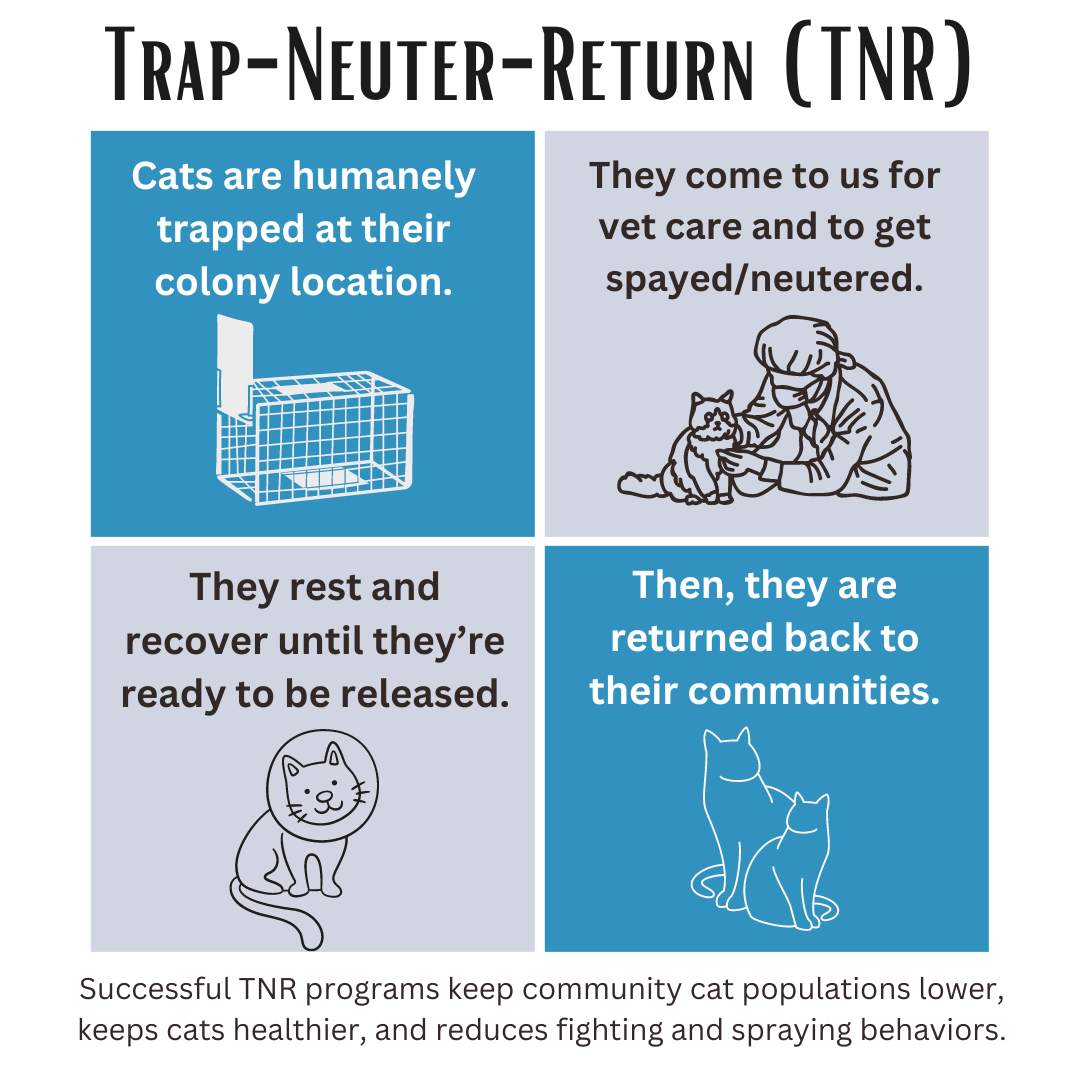Community Cats
Trap-Neuter-Return (TNR)
“Community cat” is an umbrella term that refers to any member of the Felis catus species who is unowned and lives outdoors. Both feral and stray cats are community cats.
Please do not trap and bring cats to the WCHS without first discussing your situation with us as well as securing a spay/neuter appointment! This process can take time and patience.
Placing wild, free-roaming cats in cages is terrifying for the cats and dangerous to staff and volunteers.
While we do provide spay/neuter and vaccines to community cats, these services need to be scheduled in advance. We do not actively participate in the trapping process but can provide guidance on how to successfully trap a feral cat. Please give us a call at 802-254-2232 to learn more.
Key Considerations
Trapping involves establishing a routine of once-daily feeding schedule at a fixed time, with food available for only 30 minutes. This routine, which may take several days to a week to establish, increases the likelihood of capturing the targeted feral cats just before their scheduled spay/neuter (while minimizing the chances of trapping other animals if the traps are left out 24/7). Alley Cat Allies has a Step by Step TNR Guide video.
DO NOT remove kittens from their moms before 6 weeks. There is a significant lack of foster parents for young kittens who need to be fed every four hours around the clock. Removing them when they are too young puts them at great risk.
Trapping also needs to be done when there is availability to spay/neuter as a feral cat (any cat) does not want to be in a trap for many days.
More Information
For more information on the benefits of TNR, check out Alley Cat Allies or The Community Cats Podcast.
Please also review our FAQs below.
Community Cat - Frequently Asked Questions
-
No. WCHS does not have the resources to physically participate in the trapping process. We can, however, provide guidance and advice that may help to ensure a successful outcome.
Note that all spay/neuter appointments must be scheduled in advance and are subject to availability. -
From Alley Cat Allies: “Feral, stray, and pet cats are all members of the same species; they are all domestic cats. But stray cats and feral cats are also different from each other in a very important way—in their relationship to and interactions with people.”
Check out the “cat socialization continuum.”
-
There are no leash laws for cats, which means they are allowed, by law, to roam freely. If the cat appears healthy, we recommend you leave it alone and don’t feed it. It will likely return to its home when it’s ready.
Studies have shown that cats are often “owned” by more than one cat parent, spending days with one family and nights with another. Cats do as they please, which is part of why we love them!
If you would like to discover if the cat has an owner, you can get a break-away or paper collar at the shelter and put it on the cat with a message: “Is this your cat? Please call xxx-xxxx”. This will allow you to communicate directly with the cat’s owner and rest assured the cat is being cared for.
If the cat is visibly unwell (e.g., wounded, severely underweight, losing fur), call your town’s Animal Control Officer (ACO). If they can not help, call the shelter at 802-254-2232.
Ideally, an ACO will trap and transport the cat to a veterinarian for evaluation.
Cats can carry rabies and cat bites and scratches are prone to serious infection.
-
We do not recommend feeding cats outside. Cats are opportunists and will happily eat any food you put out and will return to your yard for food even if they already have a home. Cat food outside can also attract insects and other wildlife.
-
Cats are well adapted to live in the cold as long as they have access to food, water and shelter. Community cats are more like wild animals than domesticated pets. They know where to hide and how to find food and water and they are stressed by confinement.
Some community cats eventually “come in from the cold” and adapt to living inside, but it takes a lot of time and patience, and the outcome varies from cat to cat.
Cats are individuals, and some never adapt to a life indoors.
-
WCHS follows an international policy of ear-tipping the left ear of cats (see photo above) while they are under anesthesia for their spay/neuter surgeries. This makes it easy to know right away if cats in a colony are altered. This prevents the stress of being trapped over and over for a surgery they have already had!
-
Trapping and euthanizing community cats is unlikely to get rid of a colony of cats. Studies have shown it creates a vacuum effect that invites new cats to move into the vacant area and the property owner will have to start over with spay and neuter.
Moving cats to a new location is very stressful and often leads to illness, injury or death as the cats battle for territory and have to find new places for food, water and shelter.


